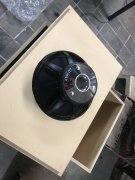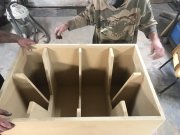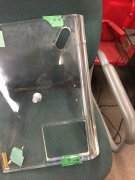AngrySailor
Veteran and General Yakker
- Joined
- Oct 15, 2014
- Messages
- 3,419
- Tagline
- ---not quite right
Hey guys, I’ve been crazy busy with work, moving transport truck loads of tractors and shop stuff half way across Canada and... upgrading the shop stereo. There’s a bit of ulterior motive in this as I plan to religate the existing shop speakers to the house “man cave” and finally set up my indoor system with the vintage gear powered by the PL-400. I’ve also had my Pioneer RT-707 repaired, the Michell turntable is in the works restoration wise (lid and feet were missing/not original), I’ve sourced a belt, stylus for the Shure V15 as well.
So the shop system has plenty of commercial amp power, it uses 4 amplifiers and an active crossover. Two sub woofer amps and separate amps for left and right stereo channels. I’ve always thought my deep low frequency response wasn’t quite where I wanted it to be (4x15” drivers), so I added two 18” drivers pictured below. I was so impressed with the improvement I planned to build more. The drivers I used were Peavey Lo-Max 18” and they were a bit pricey... just after building these cabinets, I built a car subwoofer for a friends daughter on a budget. We used Rockville 12” subs at about $35 each... it sounded so good I ordered 6 of their 18” subs at ~$110 Canadian each delivered. I figured worth a shot at that price. Also with a total of 8 drivers powered by the two sub amps, each driver in the system now only sees 600w/rms so I don’t need massive power handling speakers. There is much more to be gained by cone area as opposed to adding power.
Here’s some photos of the lo-max build, the boxes are 8 cubic feet and tuned to 33hz as per Peavey’s recommendation. I did have to lengthen the ports by about 3” to bring the resonant frequency down to 33hz even after careful measurements of displaced volume by bracing, ports and the driver itself. The Rockville build will be next, they don’t recommend any enclosure design specs only supply T/S parameters. After running the numbers they show an optimum box being something like 50 cubic feet for two drivers! I’ve worked that down to a more manageable size of 20 cubic feet for two drivers and will be a nice flat response when tuned to 26hz. By the modeling software they should reach down to 20hz at -3db or so. There will be three boxes built @ 20 cube with two drivers each for these.
I should mention that both the Peavey and cheap Rockville’s are almost 100db/wm and both are over 90db @30hz whereas the speakers I am replacing are barely 60db at 30hz peaking in the 90db range only around 60-70hz. This should be a big improvement low response!
So the shop system has plenty of commercial amp power, it uses 4 amplifiers and an active crossover. Two sub woofer amps and separate amps for left and right stereo channels. I’ve always thought my deep low frequency response wasn’t quite where I wanted it to be (4x15” drivers), so I added two 18” drivers pictured below. I was so impressed with the improvement I planned to build more. The drivers I used were Peavey Lo-Max 18” and they were a bit pricey... just after building these cabinets, I built a car subwoofer for a friends daughter on a budget. We used Rockville 12” subs at about $35 each... it sounded so good I ordered 6 of their 18” subs at ~$110 Canadian each delivered. I figured worth a shot at that price. Also with a total of 8 drivers powered by the two sub amps, each driver in the system now only sees 600w/rms so I don’t need massive power handling speakers. There is much more to be gained by cone area as opposed to adding power.
Here’s some photos of the lo-max build, the boxes are 8 cubic feet and tuned to 33hz as per Peavey’s recommendation. I did have to lengthen the ports by about 3” to bring the resonant frequency down to 33hz even after careful measurements of displaced volume by bracing, ports and the driver itself. The Rockville build will be next, they don’t recommend any enclosure design specs only supply T/S parameters. After running the numbers they show an optimum box being something like 50 cubic feet for two drivers! I’ve worked that down to a more manageable size of 20 cubic feet for two drivers and will be a nice flat response when tuned to 26hz. By the modeling software they should reach down to 20hz at -3db or so. There will be three boxes built @ 20 cube with two drivers each for these.
I should mention that both the Peavey and cheap Rockville’s are almost 100db/wm and both are over 90db @30hz whereas the speakers I am replacing are barely 60db at 30hz peaking in the 90db range only around 60-70hz. This should be a big improvement low response!
Attachments
-
 1E91B442-639C-41E1-BDC6-4CD14268BB47.jpeg2.4 MB · Views: 27
1E91B442-639C-41E1-BDC6-4CD14268BB47.jpeg2.4 MB · Views: 27 -
 C8B60941-0F74-49A8-864D-F50B75B27FD2.jpeg1.1 MB · Views: 28
C8B60941-0F74-49A8-864D-F50B75B27FD2.jpeg1.1 MB · Views: 28 -
 F26FDA47-3C26-47BF-9A91-A253C611EF42.jpeg1.2 MB · Views: 26
F26FDA47-3C26-47BF-9A91-A253C611EF42.jpeg1.2 MB · Views: 26 -
 E3E74415-EBFD-4522-8A4F-369CE7EE8EE7.jpeg1.3 MB · Views: 30
E3E74415-EBFD-4522-8A4F-369CE7EE8EE7.jpeg1.3 MB · Views: 30 -
 3F6B0D97-498B-4FBB-BE7C-8763DBD93226.jpeg2.1 MB · Views: 30
3F6B0D97-498B-4FBB-BE7C-8763DBD93226.jpeg2.1 MB · Views: 30 -
 3C760D2E-476F-4E3C-89DA-C4867DE3D10A.jpeg1.4 MB · Views: 29
3C760D2E-476F-4E3C-89DA-C4867DE3D10A.jpeg1.4 MB · Views: 29 -
 5BAE523A-F9E2-4BED-ACE6-BFE8347A320F.jpeg2.1 MB · Views: 31
5BAE523A-F9E2-4BED-ACE6-BFE8347A320F.jpeg2.1 MB · Views: 31 -
 5A798466-1249-4ED1-8CF4-6900E3168F72.jpeg1.2 MB · Views: 42
5A798466-1249-4ED1-8CF4-6900E3168F72.jpeg1.2 MB · Views: 42 -
 BDC248A6-08E9-4FAE-B6C2-3733BF38451E.jpeg2.8 MB · Views: 43
BDC248A6-08E9-4FAE-B6C2-3733BF38451E.jpeg2.8 MB · Views: 43





















